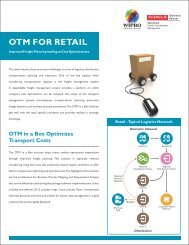Applying Change Management Practices in Government - Wipro
Applying Change Management Practices in Government - Wipro
Applying Change Management Practices in Government - Wipro
You also want an ePaper? Increase the reach of your titles
YUMPU automatically turns print PDFs into web optimized ePapers that Google loves.
CONCLUSION<br />
Figure 5: A Top-Down Strategy to Institutionalize <strong>Change</strong><br />
<strong>Government</strong> change is driven by the needs of society for better services <strong>in</strong> areas the <strong>Government</strong><br />
feels it needs to exist. In many countries, the <strong>Government</strong> forays <strong>in</strong>to areas where private<br />
enterprise might rationally be better suited; this is often due to political compulsions. In India,<br />
for example, the <strong>Government</strong> privatized bank<strong>in</strong>g and placed tremendous restrictions on private<br />
banks. It also ran Aviation for many years; today private airl<strong>in</strong>es have more than 80% of the<br />
aviation market. Runn<strong>in</strong>g postal services have long been assumed to be someth<strong>in</strong>g a <strong>Government</strong><br />
must do; yet, as an example, the Dutch <strong>Government</strong> has successfully, privatized the postal<br />
services.<br />
Today's citizen does not wish to dist<strong>in</strong>guish between the corporate and the government and<br />
expects the same level of service and responsiveness from both. He will stick to government<br />
services <strong>in</strong> the follow<strong>in</strong>g circumstances:<br />
1. There is no alternative<br />
2. The free-market alternative is not affordable<br />
3. The free-market alternative does not provide precisely what he needs<br />
4. Mistrust of the alternative because of a lifetime of expectations that the government exists<br />
to provide certa<strong>in</strong> k<strong>in</strong>ds of citizen services, which may vary from country to country.<br />
Where government-driven <strong>in</strong>stitutions are able to react quickly and change for the better, the<br />
consumer is will<strong>in</strong>g to return, often because he may view the alternative as risky and the<br />
government as 'safe'. He will be will<strong>in</strong>g to tolerate slower service from a <strong>Government</strong> <strong>in</strong>stitution<br />
to a po<strong>in</strong>t equivalent to his tolerance of perceived risk of the corporate alternative.<br />
Moreover with <strong>Government</strong> Organizations mak<strong>in</strong>g public announcements about various schemes<br />
and projects, a citizen is also more aware about beneficial schemes available for him. If the<br />
<strong>Government</strong> employee is not suitably ready to deliver his expand<strong>in</strong>g roles, then there is a fear of<br />
public outrage as well. The demand<strong>in</strong>g and impatient consumer may therefore be the true<br />
trigger for government <strong>in</strong>stitutions to change. Inertia and atrophy cause this change to come<br />
about slower than expected; change management consultants need to spend time on<br />
understand<strong>in</strong>g organizational dynamics and the profile of a <strong>Government</strong> employee.<br />
8

















